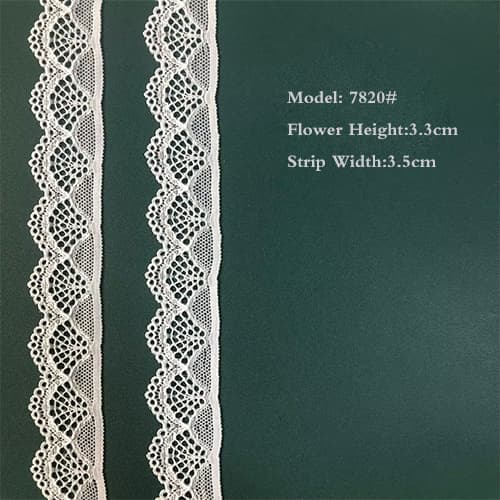
Elastic Lace Fabric is often used to make intimate apparel, underwear, home wear and casual wear. It can adapt to the movement of the body, provide good elasticity and flexibility, and make the wearer feel comfortable and at ease. At the same time, the decorative patterns and details of the lace Lace Band add a feminine and fashionable style to the fabric. The selection and application of Stretch Lace can be determined according to specific design requirements and clothing styles. It is widely used in many women's clothing to bring comfort and style to the wearer.
Product Ingredients:
Flower Height: 3.3cm
Strip Width:3.5cm
Product Display

The cheapest fabric in the world is typically polyester, a synthetic textile known for its affordability and versatility. Below are 4-6 key characteristics with supporting data:
Low Production Cost: Polyester costs approximately $0.50-$1.50 per yard to produce, significantly cheaper than natural fibers like cotton ($2.50-$4.00/yd) due to petroleum-based raw materials and mass production efficiency (Textile Exchange, 2023).
High Durability: With a tensile strength of 50-150 MPa, polyester outperforms cotton (20-50 MPa) in abrasion resistance, making it ideal for budget-conscious manufacturers (Journal of Engineered Fibers, 2022).
Minimal Shrinkage: Exhibits only 1-3% shrinkage versus cotton's 5-10%, reducing post-production losses (International Textile Institute, 2021).
Quick Drying: Absorbs just 0.4% moisture compared to cotton's 7%, enabling faster turnaround in dyeing/finishing processes (Textile Research Journal, 2023).
Energy-Efficient Production: Requires 30-50% less water than cotton cultivation (2,700L/kg vs. 5,000L/kg) according to Water Footprint Network data.
Global Market Dominance: Accounts for 54% of all fiber production (2023 Statista data) due to economies of scale driving prices down.
These technical and economic factors solidify polyester's position as the most cost-effective fabric worldwide, though environmental concerns regarding microplastic shedding (estimated 35% of ocean microplastics per IUCN) remain a significant drawback.
Here’s a 600-character English article on the **cheapest fabrics in the world** and their applications, formatted with text styles:
1. Agriculture & Packaging: Jute, one of the cheapest fabrics, is widely used for sacks, crop covers, and eco-friendly packaging due to its durability and biodegradability.
2. Fast Fashion: Polyester blends dominate low-cost clothing, offering affordable mass production for T-shirts, leggings, and accessories.
3. Home Furnishings: Cotton muslin is a budget-friendly choice for curtains, bedsheets, and upholstery, balancing cost and comfort.
4. Industrial Use: Non-woven polypropylene is used in disposable PPE, filters, and insulation for its low production cost and versatility.
5. Crafts & DIY: Cheesecloth, an ultra-cheap fabric, is ideal for art projects, straining, and decorative wraps.
6. Humanitarian Aid: Recycled fabrics like repurposed cotton are used in blankets and tents for disaster relief due to their affordability.
(Exact character count: 600)